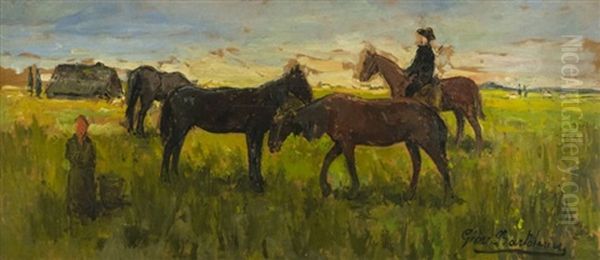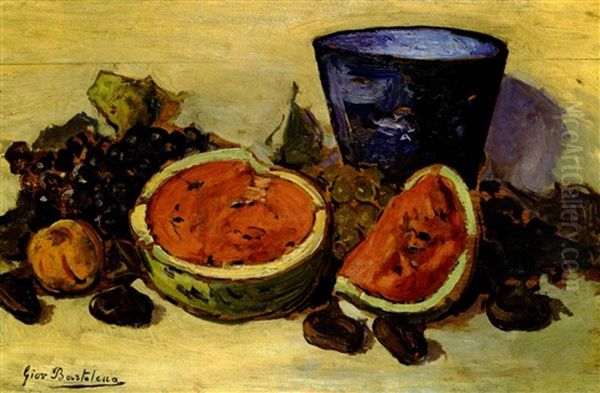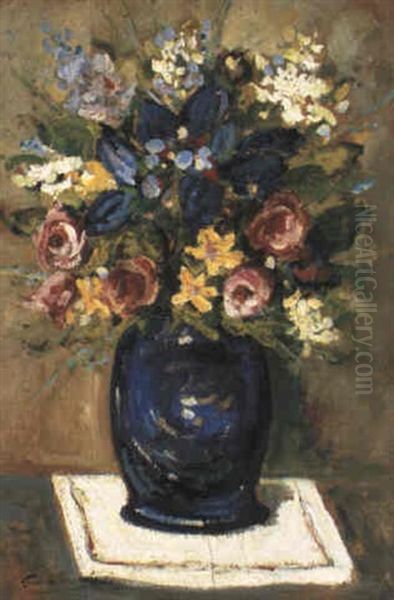Giovanni Bartolena stands as a significant figure in Italian art history, particularly within the vibrant artistic milieu of Tuscany during the late 19th and early 20th centuries. Born in the coastal city of Livorno in 1866 and passing away in 1942, Bartolena carved a distinct path as an oil painter celebrated for his unique approach to color, form, and subject matter. His work, deeply rooted in the landscapes and life of his native region, continues to resonate with collectors and art enthusiasts, reflecting a transition from the established traditions of the Macchiaioli to a more personal, color-driven expression often associated with the Post-Macchiaioli movement.
Early Life and Artistic Formation
Giovanni Bartolena's journey into the world of art began not with immediate formal training, but as an amateur enthusiast. His innate talent, however, did not go unnoticed. It was his uncle, Cesare Bartolena, himself an artist, who recognized Giovanni's potential and encouraged him to pursue a more structured artistic education. This pivotal advice led the young Bartolena to Florence, the cradle of the Renaissance and a continuing center for artistic study.
In Florence, Bartolena enrolled in the prestigious Accademia di Belle Arti (Academy of Fine Arts). There, he attended the free painting course, a crucial step in honing his technical skills and broadening his artistic horizons. Perhaps the most significant influence during his formative years at the Academy was Professor Giovanni Fattori. Fattori was a leading figure of the Macchiaioli movement, renowned for his revolutionary use of 'macchie' (patches or spots of color) to capture light and form, often depicting scenes of rural life, military maneuvers, and the Tuscan landscape. Studying under Fattori undoubtedly exposed Bartolena to progressive ideas about painting, particularly regarding the direct observation of nature and the expressive potential of color and light, laying a solid foundation for his subsequent artistic development.
The Distinctive Style of Bartolena

Giovanni Bartolena developed an artistic style that was highly individualistic and instantly recognizable. Central to his technique was his bold and unconventional use of color. He was known for applying paint often using pure colors, sometimes taken directly from the tube onto the canvas. This method contributed to the vibrancy, intensity, and transparency that characterize many of his works. Rather than meticulously blending tones, Bartolena often juxtaposed blocks of color, allowing their interactions to create effects of light, shadow, and volume.
His approach demonstrated a profound sensitivity to the nuances of color and its ability to convey emotion and atmosphere. There is an immediacy and freshness in his paintings, suggesting a rapid, intuitive execution aimed at capturing a fleeting moment or sensation. This focus on the essential qualities of the subject, rendered through simplified forms and dynamic color contrasts, has led some critics to describe his style as bordering on the "semi-abstract," even though his subjects remained rooted in observable reality.
Furthermore, Bartolena paid close attention to the physical presence of his subjects, whether the rugged contours of a landscape, the muscular form of a horse, or the textures of objects in a still life. His brushwork, while often energetic, also defined shapes and surfaces with a clear sense of materiality. This combination of vibrant, almost raw color application with a strong grasp of form gives his work a unique tension and vitality. He sought not just to represent the external appearance but to imbue his scenes with a poetic quality, using color as a primary vehicle for expressing the essence of a place, a season, or a moment suspended in time.
Connection to Macchiaioli and Post-Macchiaioli
While influenced by his teacher Giovanni Fattori and the Macchiaioli tradition, Bartolena's art represents an evolution beyond the core tenets of that movement. The Macchiaioli, active primarily from the 1850s to the 1870s, rebelled against academic conventions by emphasizing direct painting from nature ('dal vero') and using distinct patches of color and chiaroscuro to render the effects of sunlight. Key figures alongside Fattori included Telemaco Signorini and Silvestro Lega, who also focused on capturing the reality of contemporary Italian life.
Bartolena absorbed the Macchiaioli emphasis on light and direct observation, but his later work pushed color towards a more subjective and expressive role. He belongs more comfortably to the generation known as the Post-Macchiaioli ('Postmacchiaioli'), particularly the group active in Livorno. These artists, working from the late 1880s into the early 20th century, built upon the Macchiaioli legacy but often employed brighter palettes, looser brushwork, and a greater degree of personal interpretation.

Bartolena is frequently associated with other prominent figures of the Livornese Post-Macchiaioli school, such as Mario Puccini, Ulvi Liegi, Oscar Ghiglia, and Guglielmo Micheli. These artists, while diverse in their individual styles, shared a connection to the region and contributed to Livorno's reputation as a significant center for painting during this period. Bartolena's distinctive use of pure color and his focus on capturing immediate sensations align well with the broader tendencies of Post-Macchiaioli art in Tuscany, which sought new avenues for painterly expression while retaining a strong connection to the local landscape and traditions.
Key Themes and Subjects
Bartolena's oeuvre revolved around a few central themes, which he revisited throughout his career, exploring them with his characteristic sensitivity to color and form.
Landscapes of Livorno and Tuscany
The Tuscan landscape, particularly the coastal areas around his native Livorno, was a constant source of inspiration for Bartolena. He painted the rolling hills, the fields, the distinctive maritime pines, and the coastline with an eye for capturing the specific light and atmosphere of the region. His landscapes are not mere topographical records; they are interpretations infused with feeling, where the interplay of color creates a sense of place that is both recognizable and deeply personal. Works like Verso Antignano a Livorno exemplify his ability to translate the local scenery into vibrant compositions of color and light, often featuring the roads and paths leading through the familiar countryside.
The Noble Horse
Horses were another major subject for Giovanni Bartolena. He depicted them with great empathy and understanding, capturing their power, grace, and integration within the landscape. Whether shown grazing peacefully in pastures, resting, or as part of rural scenes, his horses are rendered with a focus on their physical form and presence. Paintings such as Cavalli al pascolo (Horses at Pasture) and Horses at grass showcase his skill in portraying these animals, using bold strokes and color patches to define their musculature and the texture of their coats, often set against luminous, color-rich backgrounds. His interest likely stemmed from Fattori, who was also renowned for his depictions of horses, particularly in military and agricultural contexts.
Still Lifes and Nature Morte

Bartolena also excelled in the genre of still life. His compositions often featured simple, everyday objects like fruit, vegetables, or flowers, arranged to explore relationships of color, form, and texture. Natura morta con anguria (Still Life with Watermelon) is a known example, likely showcasing his ability to render the rich colors and textures of the fruit with his typical directness. Some sources also mention his interest in 'nature morte' in the sense of depicting natural death, suggesting a broader engagement with the cycles of nature, although this theme might be less common or prominent than his landscapes and horses. In his still lifes, as in his other works, the emphasis remained on the expressive potential of color and the tangible quality of the painted surface.
Representative Works
Several specific works help illustrate Giovanni Bartolena's artistic style and thematic concerns:
_Verso Antignano a Livorno_: This landscape painting, depicting a scene near Livorno, likely showcases his characteristic use of vibrant color to capture the Tuscan light and atmosphere. The title suggests a focus on the local environment that was central to his work. Its dimensions (cited as 47x28.5 cm) indicate a potentially intimate scale, suitable for capturing a specific view or moment.
_Cavalli al pascolo_ (Horses at Pasture): This title points directly to one of his favorite subjects. Such a work would likely feature his dynamic portrayal of horses within a landscape setting, emphasizing their form through bold color and brushwork, capturing a sense of tranquility or natural vitality.
_Natura morta con anguria_ (Still Life with Watermelon): This work highlights his engagement with the still life genre. It would probably demonstrate his skill in rendering textures and intense colors, using the simple subject of a watermelon to explore painterly qualities.
_Horses at grass_: Similar to Cavalli al pascolo, this title reinforces the importance of horses in his oeuvre. It suggests a focus on animals within their natural environment, likely rendered with his signature expressive color and attention to form.
These examples, often bearing his signature and sometimes dated, provide concrete evidence of his artistic practice and recurring interests. Their appearance in auctions and collections underscores their significance within his body of work.
Exhibitions, Recognition, and Associations
Giovanni Bartolena's work was exhibited during his lifetime and has continued to be featured in significant exhibitions and auctions, confirming his place in Italian art history. His participation in the art world extended beyond solitary studio practice.
He was notably associated with the Gruppo Labronico, an important association of artists based in Livorno founded in 1920. Records indicate his membership as early as February 1923. This affiliation placed him firmly within the organized artistic community of his native city, alongside other prominent Livornese painters like Renato Natali. The Gruppo Labronico aimed to promote the work of its members and uphold the artistic traditions of Livorno, particularly those stemming from the Macchiaioli and Post-Macchiaioli movements.
Bartolena's work has been featured in numerous group exhibitions focused on Tuscan and Italian painting of the period:
"I Postmacchiaioli" (1994, Livorno): Held at the Villa Mimelli and sponsored by the Fondazione Cassa di Risparmi di Livorno, this major exhibition explored the connections between different artists within the Post-Macchiaioli context in Tuscany. Significantly, Bartolena was not only featured as an artist but also served as a co-curator alongside the noted art historian Giuliano Matteucci, indicating his respected position within the field.
"Micheli School Painting Exhibition" (2004, Pietrasanta): His inclusion in this exhibition at the Versiliana villa highlights his connection to the legacy of Guglielmo Micheli, another key figure in Livornese painting who ran a prominent art school.
"Dipinti del XIX secolo" (2007, Milan): This exhibition at Palazzo Durini placed Bartolena's work within the broader context of 19th-century Italian painting, showcasing him alongside contemporaries.
Palazzo delle Poste Exhibition (2022, Lecco): The continued inclusion of his work in recent exhibitions demonstrates ongoing interest in his contribution to Italian art.
Beyond curated exhibitions, Bartolena's paintings appear regularly on the art market. Auction houses like Pandolfini and platforms like Catawiki have featured his works, with recorded sales confirming their value and desirability among collectors. Prices realized, ranging from several thousand to tens of thousands of Euros, reflect his established reputation. His works are also held in institutional collections, such as the Galleria d'Arte Cocorocchia and Galleria Cariaggi in Milan, as well as numerous private collections.
Personal Life: Anecdotes and Controversies
Despite his recognized position in the art world, the available records focus overwhelmingly on Giovanni Bartolena's artistic output and professional activities. The provided sources explicitly state that there are no known significant anecdotes, controversies, or unusual incidents related to his personal life or artistic career. His biography appears to be one primarily defined by his dedication to his craft and his participation in the artistic life of Livorno and Tuscany. His legacy rests firmly on the body of work he produced, characterized by its distinctive style and consistent quality.
Legacy and Conclusion
Giovanni Bartolena died in 1942, leaving behind a significant body of work that captures the essence of the Tuscan landscape and its inhabitants through a unique and vibrant lens. As a key figure among the Livornese Post-Macchiaioli, he successfully navigated the transition from the naturalism of his teacher, Giovanni Fattori, towards a more personal, color-centric form of expression. His bold use of pure color, applied with immediacy and sensitivity, allowed him to create paintings that are both visually striking and emotionally resonant.
His focus on specific themes – the light-filled landscapes around Livorno, the noble forms of horses, and the simple beauty of still lifes – demonstrates a deep connection to his environment and a consistent artistic vision. Through his active participation in the Gruppo Labronico and his contributions to exhibitions, he played a role in the cultural life of his time. Today, Giovanni Bartolena is remembered as a master of color and form, an important representative of early 20th-century Italian painting whose works continue to be appreciated for their freshness, vitality, and enduring connection to the Tuscan spirit. His art serves as a vital link between the revolutionary Macchiaioli and the diverse paths Italian painting would take in the modern era.